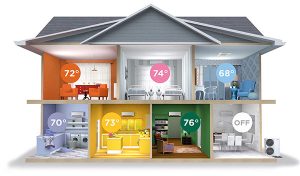 Get energy-efficient, target cooling for your home.
Get energy-efficient, target cooling for your home.
Summer in the Northeast can mean a lot of great things like al fresco meals, dips in the pool and ice cream at sunset. One less-than-pleasant aspect of the summer is the increase in electricity consumption that comes with air conditioning.
For most American households, home cooling systems are the single largest user of electricity. On sweltering summer afternoons, you may be running your central A/C or ductless mini-splits for hours on end. This leaves many homeowners sweating over their energy bills and looking for ways to reduce A/C usage.
One way to lower your A/C costs is to look into multi–zone cooling. In this article, we’ll discuss what zoned cooling is and whether it’s a viable option for your home.
What is Multi-Zone Cooling?
A multi-zone A/C system transforms your home into customized climate zones, each equipped with its own thermostat for personalized temperature control. Connecting multiple indoor units to a single outdoor unit ensures precise cooling, so you can leave unoccupied spaces warmer and save money on power consumption. Zoned cooling also allows everyone in the house to enjoy their ideal comfort level without impacting others.
What’s the Difference Between Central A/C and Ductless Mini-Splits?
The two most popular cooling options that Mirabito Energy Products installs are central A/C systems and ductless mini-splits.
Central A/C systems consist of two main components: an outdoor condenser unit and an indoor unit, typically housed in a basement, attic or utility space. The indoor unit has a blower fan that connects to your home’s ductwork. These systems work by extracting heat from your indoor spaces and circulating cooled air through ducts and vents. In most cases, the ductwork used for your home’s furnace can also accommodate the central A/C system. Controlled by a central thermostat, these systems provide seamless and efficient temperature regulation throughout your home.
Like central A/C systems, ductless mini-splits have both an outdoor and indoor unit. Refrigerant circulates through the system, absorbing heat and humidity from the indoor air before releasing the heat outside via thin tubing. Mini-splits require an indoor air handling unit in each room or zone needing air conditioning. These units come as wall-mounted, ceiling-mounted, floor-mounted, or in-ceiling, each of which connects to an outdoor unit.
Can Central A/C and Mini-Splits Both Provide Central Cooling?
Ductless A/C systems offer zoned cooling because each indoor air handler functions independently. You can set each unit to a different temperature and power some down entirely. This makes it extremely easy to cool different zones at varying levels and maximize your system’s efficiency.
It is also possible to add zones to a central A/C setup, but how viable it is depends on your cooling equipment. Variable speed systems are more conducive to zoning. Retrofitting ductwork and adding HVAC dampers may be necessary to create multiple cooling zones in a central A/C system. An HVAC professional like the techs at Mirabito can assist you in determining if multi-zone cooling is a good option for your household.
If you’re interested in upgrading your home’s A/C capabilities, reach out to Mirabito Energy Products for a free consultation and estimate. Our team serves households in New York, Pennsylvania, Rhode Island, Connecticut, Vermont and Massachusetts.